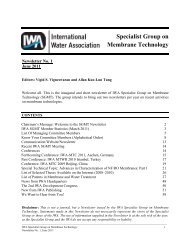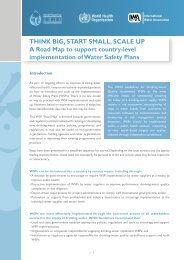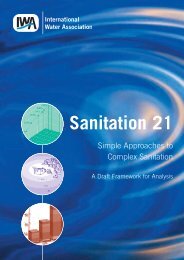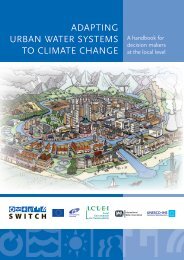Specialist Group on ANAEROBIC DIGESTION Newsletter - IWA
Specialist Group on ANAEROBIC DIGESTION Newsletter - IWA
Specialist Group on ANAEROBIC DIGESTION Newsletter - IWA
You also want an ePaper? Increase the reach of your titles
YUMPU automatically turns print PDFs into web optimized ePapers that Google loves.
UPDATE FROM THE TASK GROUPS ON <strong>ANAEROBIC</strong> <strong>DIGESTION</strong><br />
<strong>IWA</strong> Task <str<strong>on</strong>g>Group</str<strong>on</strong>g> <strong>on</strong> Mathematical Modelling of Anaerobic Digesti<strong>on</strong><br />
The <strong>IWA</strong> Anaerobic Digesti<strong>on</strong> Modelling Task <str<strong>on</strong>g>Group</str<strong>on</strong>g> is currently not active, but we have observed a number of<br />
developments in the area. A workshop was held at WWTmod 2008 in Quebec, Canada. This was aimed at<br />
identifying some of the key limitati<strong>on</strong>s of the ADM1 for practical use. The two major issues identified were<br />
characterisati<strong>on</strong> of influents, and the physicochemical system. In particular, for the latter, it was identified that<br />
phosphorous still could not be effectively modelled in anaerobic digesters (or in aerobic systems). The <strong>IWA</strong><br />
Benchmarking Model Taskgroup has partly addressed the first issue as Nopens, et al. (2009) "An ASM/ADM<br />
model interface for dynamic plant-wide simulati<strong>on</strong>" Wat. Res. 43(7): 1913-1923. This provides an input model<br />
for relatively straight forward definiti<strong>on</strong> from activated sludge, and can be readily adapted to other substrates.<br />
The main task remaining is providing reference applicati<strong>on</strong>s of this input model to areas other than activated<br />
sludge. The issue of advanced physicochemical models is more involved, and some of the challenges have been<br />
further outlined in Batst<strong>on</strong>e, D.J. (2009) “Towards a generalised physicochemical modelling framework”<br />
Reviews in Envir<strong>on</strong>. Sci. Biotech 8(2):113.<br />
Damien Batst<strong>on</strong>e, Chair of ADM Task <str<strong>on</strong>g>Group</str<strong>on</strong>g><br />
<strong>IWA</strong>-AD Task <str<strong>on</strong>g>Group</str<strong>on</strong>g> <strong>on</strong> Harm<strong>on</strong>izati<strong>on</strong> of Anaerobic Biodegradati<strong>on</strong>, Activity and Inhibiti<strong>on</strong> Assays<br />
(TG ABAI)<br />
The ABAI TG has the objective to harm<strong>on</strong>ise anaerobic biodegradability, activity and inhibiti<strong>on</strong> assays. The<br />
group met last time for a workshop in Prague, where a report was written summarising the discussi<strong>on</strong>s during<br />
the ABAI TG. Based <strong>on</strong> the work of ABAI TG a paper was presented by at the Solid waste c<strong>on</strong>ference by David<br />
Bolz<strong>on</strong>ella in Hemet, Tunesia. The paper has been recently published:<br />
I. Angelidaki, M. Alves, D. Bolz<strong>on</strong>ella, L. Borzacc<strong>on</strong>i, J. L. Campos, A. J. Guwy, S. Kalyuzhnyi, P.<br />
Jenicek and J. B. van Lier (2009). Defining the biomethane potential (BMP) of solid organic wastes and<br />
energy crops: a proposed protocol for batch assays. Water Sci. Technol. 59(5), pp. 927-934<br />
Irini Angelidaki, Chair of the ABAI-TG<br />
<strong>IWA</strong> <str<strong>on</strong>g>Specialist</str<strong>on</strong>g> <str<strong>on</strong>g>Group</str<strong>on</strong>g> <strong>on</strong> Anaerobic Digesti<strong>on</strong><br />
4 June 2009 <strong>Newsletter</strong>

















